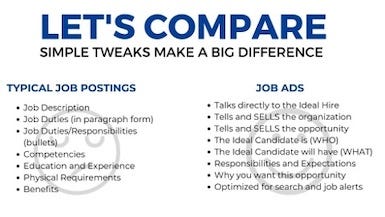These two things are not the same—but executing both well is a must for recruiting and retaining successful employees.

Hiring people well-matched to their roles requires approaching the process with clarity. A key component of gaining such clarity is writing a thorough, effective job description—one that’s clear on the goals and objectives of the position. That job description can then become the basis for writing an effective job ad, but they are not the same.
Let’s start by tackling the differences: A job description provides a solid overview of the position, sets expectations and legally protects the company. However, most descriptions are too long and rudimentary to be effective as job ads. A well-written job ad should function more like marketing copy—it stands out and makes people want to work for your company.
How to Write a Top-Notch Job Description
A written job description provides a guide for the hiring manager and company throughout the hiring process. If you know the results you're expecting and the activity it takes to get those results, you’ll know what makes a good candidate; what necessary experience, education and personality characteristics they need; and how to measure the success of your hire.
Here are four tips for writing a quality job description:
1. Determine the business need for the position
One of the most common mistakes leaders make when hiring is not establishing clarity before hiring. The business needs for the position must be clear from the outset of the hiring process. What are the results you need to see to justify the cost of payroll and the time and energy spent on training and managing the new hire?
2. Set clear goals and expectations for the new hire
It’s not enough to have an expectation for results. If you don’t know what the new hire must do to succeed, how can you expect them to know what to do and how to do it? Setting clear guidelines for activity and results is easier for some roles than others, but to get the best ROI, you must come up with an educated guess that can be refined over time if needed.
High performers like to know what is expected so they can meet and exceed the target. As a company owner or team manager, you need to communicate these expectations so, if there are questions about the new hire’s ability to succeed in a role later, there is something specific to address when discussing performance concerns with the employee.
3. Be clear about their day-to-day activities
Start simple: Brain-dump all the tasks and responsibilities the new hire will complete on a daily, weekly, monthly and quarterly basis. It’s particularly helpful to create a document with sections for tasks, responsibilities, tools and miscellaneous details. That way, you ensure you’re covering the key aspects of the role and can use this document later to create job description bullets describing the role.
4. Note what soft skills you desire
You’ve already spent time figuring out exactly the type of person you want in terms of skills, background and what they will need to accomplish as an employee. Now, it’s time to turn to the intangibles: What kind of soft skills will they need? Is this role a detail-oriented position or more of a gregarious and engaging position?
People are more than just skills and experience. The best hires come when someone has the skills and the personality to thrive in the role and environment. Weave these into the role summary and the bullets of your job description. There are plenty of examples and job description templates online that you can use to kick off your writing process.
How to Write a Successful Job Ad
A job ad is based on the job description, but it should be written with the goal of attracting the right people to read it and then inspire them to apply.
Follow this seven-step framework to create a compelling job ad that will get more applicants for your job openings:
1. Tell them about the company
This should be a brief company bio—one that you can probably pull from your “about us” page or marketing copy. For example, XYZ Company was founded in 1978 and serves the residential and commercial construction markets. There’s no need to reinvent the wheel if your company has spent time and resources crafting a clear, concise company description.
2. Sell them on the company
Share why your company or organization is a great place to work. Include phrases like, “We are privately held, offer a family-friendly environment and foster a culture of success.”
Brag a little bit. Comments like, “We have won numerous awards for our work/work environment” are great details to include (as long as they’re true).
3. Describe exactly what you’re looking for
This is your “we are seeking” statement. Describe the ideal hire’s attributes and experience (e.g., “an outgoing, achievement-oriented salesperson”). Share what past successes someone applying to the role should have and what experiences they should demonstrate. Be sure to list any certifications or licenses needed or preferred.
4. Sell them on the opportunity using a bulleted list
Keep this short to hold the reader’s attention. Here are some ideas to get you started.
What opportunities will the new hire have?
What perks will they be eligible for?
What are the great things about working for your company and in this role specifically?
5. List your deal-breakers
What are the reasons you won't move forward with a candidate, and what are the reasons a candidate may choose not to move forward? Include these in your job ad to save time for both parties.
This often includes licenses, scheduling considerations and certifications for employers, and schedule requirements or an undesirable location for candidates.
6. Include a clear call-to-action
In this case, the call to action is obvious. You want them to send in a resume. Make sure it is easy for people to apply. Allowing people to apply with social media or online profiles is a great way to increase applications.
Note: If it takes more than three minutes to complete the application, you’ll lose applicants.
7. Check your work
Don't stop yet! Take a quick break from your work, then come back with fresh eyes and read it as if you're the ideal hire. Does it excite you? Does it make you want to apply?

Rikka Brandon is a nationally recognized building industry recruiting and hiring expert, and best-selling author. She helps building industry business owners and leaders solve their recruiting and retention challenges with strategy, best practices and access to experts. Whether or not you’re looking for in-house training and coaching for your team or an expert to provide consulting, you can learn more at BuildingGurus.com/Informa.
About the Author(s)
You May Also Like




